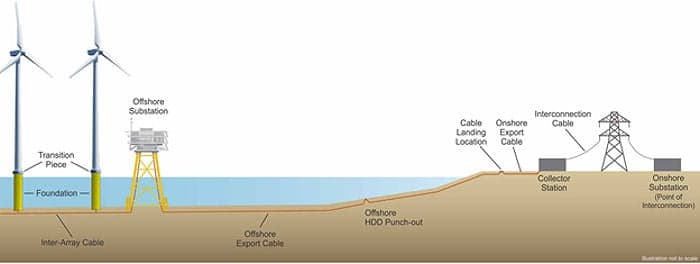Dominion Energy has proposed Coastal Virginia Offshore Wind (CVOW), the first large offshore wind project in the United States. CVOW would be a 2.6 GW wind farm consisting of 176 15 MW wind turbines, 3 offshore electric substations, underwater and onshore power delivery cables, a collector station and an interconnection to the existing Dominion grid.

The estimated cost of the project is $10 billion, or approximately $57 million per wind turbine. The 15 MW Siemens Gamesa wind turbines are the largest commercially available wind turbines and will be mounted 800 feet above mean sea level, approximately 27 miles offshore of Hampton, VA.
The International Energy Agency (IEA) estimates the annual capacity factor of offshore wind turbines at 50%. I will use this estimate, since there is no commercial experience with these new wind turbines and no experience with offshore wind turbines in the Norfolk, VA area. At this capacity factor, the actual average annual capacity of the CVOW wind farm would be approximately 1.3 GW, fluctuating over a range from 0 – 2.6 GW. The output of the CVOW wind farm, as proposed, is non-dispatchable. Therefore, it would require either conventional generation backup or massive electricity storage capacity.
The daily average power generated by the CVOW wind farm would be approximately 31 GWh (1.3 * 24). Therefore, storage capacity of approximately 31 GWh would be required to replace wind farm output for each low/no wind day. Replacing wind farm output over a 10-day wind drought similar to that experienced in the UK and Western Europe in the Fall of 2021 would require long-duration storage of more than 300 GWh. Such long-duration storage is not currently commercially available and there is no schedule for its commercial availability.
The National Renewable Energy Laboratory (NREL) estimates the current cost of 4-hour battery storage at $350/kwh. This cost is projected to drop to an average of $150/kWh by 2050. Since long-duration storage capable of a 10-day operating cycle is not commercially available and its future cost is unknown, I will use the current cost of 4-hour storage to estimate the cost of making the output of the CVOW wind farm dispatchable. The approximate 300 GWh long-duration storage requirement is equal to 300,000,000 kWh, at a storage system cost of $350/kWh, or a total cost of approximately $105 billion, or approximately 10 times the cost of the wind farm.
Storage is a passive component of the overall wind energy system. Storage must be charged with surplus electricity generated by the wind farm or elsewhere in the Dominion grid; and, it must also be recharged after each use. While this could be accomplished today using the Dominion grid’s conventional generation capacity reserve margin, charging and recharging in a renewable plus storage grid would require additional renewable generating capacity beyond the capacity required to serve the contemporaneous demand of the grid. The additional renewable generating capacity required to charge and recharge storage would be determined by the number of days allowed for charging and especially recharging storage.

